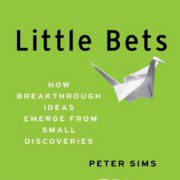Little Bets
Book Review: Little Bets by Peter Sims
I discovered Little Bets through an Amazon announcement, and as soon as I read the promotional copy, I hurried to purchase the book:
What do Apple CEO Steve Jobs, comedian Chris Rock, prize-winning architect Frank Gehry, the story developers at Pixar films, and the Army Chief of Strategic Plans all have in common? Bestselling author Peter Sims found that all of them have achieved breakthrough results by methodically taking small, experimental steps in order to discover and develop new ideas. Rather than believing they have to start with a big idea or plan a whole project out in advance, trying to foresee the final outcome, they make a series of little bets about what might be a good direction, learning from lots of little failures and from small but highly significant wins that allow them to happen upon unexpected avenues and arrive at extraordinary outcomes.
The good news? Little Bets absolutely delivers on that tantalizing introduction.
Peter Sims has identified two types of innovators: conceptual innovators, who make the big, bold leaps with groundbreaking new ideas (and, according to Sims, often achieve their success early) and experimental innovators, who “use experimental, iterative, trial-and-error approaches to gradually build up to breakthroughs.” Experimental innovators are persistent and willing to accept failure and setbacks because they understand that those events are learning opportunities. Rather than perceiving failure to reflect self-worth, experimental innovators use failure as feedback.
One example of experimental innovation comes through Starbucks. Sims recounts Howard Schultz’s initial ideas: bow-tied baristas dispensing coffee from a menu written in Italian with a background of opera music. This did not work.Rather than declaring failure and moving on to a new project (or simply getting a job implementing others’ ideas), Schultz began to make adjustments, tweaking aspects of Starbucks over time. And now, the Starbucks concept has come to define not just how we order, purchase, and drink coffee, but it’s come to represent (to some extent) where and how we gather in community. Whether you like or detest Starbucks, it is innovation in action.
Through examples drawn from a wide variety of industries, Little Betsexplains the characteristics of experimental innovators, who
- Experiment. These innovators “[l]earn by doing [and] [f]ail quickly to learn fast.”
- Play. Improvisation and a light, humorous approach quiets inhibitions and allows innovation to flourish. Compare a brainstorming session in which every idea, no matter how objectively ridiculous, is considered with one that includes the naysayer who punctuates every idea with “that won’t work!”
- Always seek new input. Experimental innovators leave their workspace in search of fresh ideas and insights, and they aim to understand people’s motivations and desires. Consider the feedback on Siri, the new voice assistant built into the iPhone 4S, which answers voice commands and questions with human-like responses. Wouldn’t you imagine that Siri came about in response to the desire to have a pocket genie?
- Redefine. Experimental innovators use the insights they gather to define problems and needs before seeking to create a solution. Compare the Segway with smartphones. We needed a way to be connected on the go (and the level of connection has continued to evolve), but most of us didn’t really need a new way to get around.
- Reorient. Experimental innovators keep their larger goals in view while remaining flexible so that they can make good use of each small win that occurs.
- Iterate. Experimental innovators “[r]epeat, refine, and test frequently armed with better insights, information, and assumptions as time goes on[.]”
Why should you consider the Little Bets approach? No one wants to fail, and there’s no credible way to redefine failure itself as a positive. However, I’ve often observed lawyers and business owners who fail, take that failure as a reflection not of a faulty plan or faulty efforts but rather as an indicator that they cannot succeed. (This is especially prevalent with the would-be rainmaker who makes a few attempts, doesn’t get any business, and concludes that they just don’t have what it takes.)
And yet, we all fail. The question is what we do with that failure. Using the Little Bets approach recognizes that failure isn’t fatal when it’s a step toward success.Determine what you can afford to lose (a key lesson taught through Steve Jobs’ experience in growing Pixar) and then get to testing. Don’t lose more than you can afford, and find ways to grow from each failure.
Finally, experimental innovation is not an all-or-nothing proposition. “To be sure, experimental innovation should not entirely replace linear thinking in our regular work processes. Engaging in discovery and making little bets is a way to complement more linear, procedural thinking.” Use experimental innovation to guide your approach, to road-test the ideas and assumptions that come through rational, strategic thinking.




Leave a Reply
Want to join the discussion?Feel free to contribute!